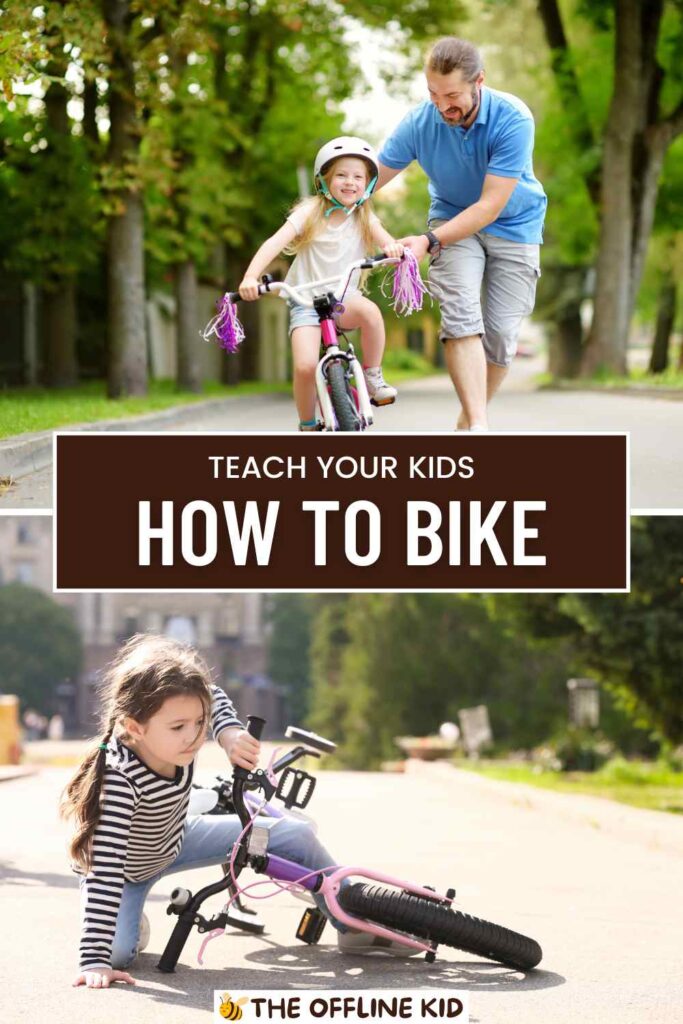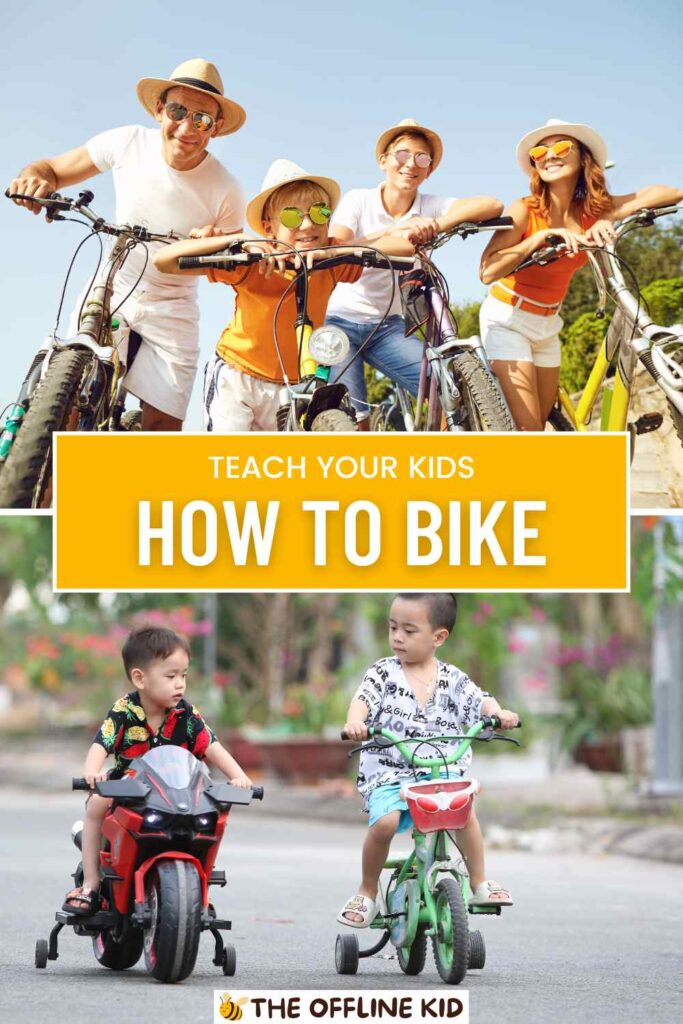Introducing biking to your child is an exciting milestone, filled with opportunities to explore, learn, and build confidence.
From choosing the right gear to guiding them in their first wobbling pedal strokes, this comprehensive guide will help you navigate every step.
Get ready to see smiles and hear laughter on two wheels!
Preparing for the Journey
Before diving into lessons on balance and coordination, it’s crucial to set the stage for a positive biking experience.
Children are more receptive to learning when they feel safe, motivated, and excited. Begin by creating an environment that sparks curiosity and enthusiasm around bikes.
Talk about the freedom and fun that biking offers—like racing down the sidewalk or exploring the neighborhood park with friends. These conversations will instill a sense of adventure and wonder, making them eager to give biking a try.
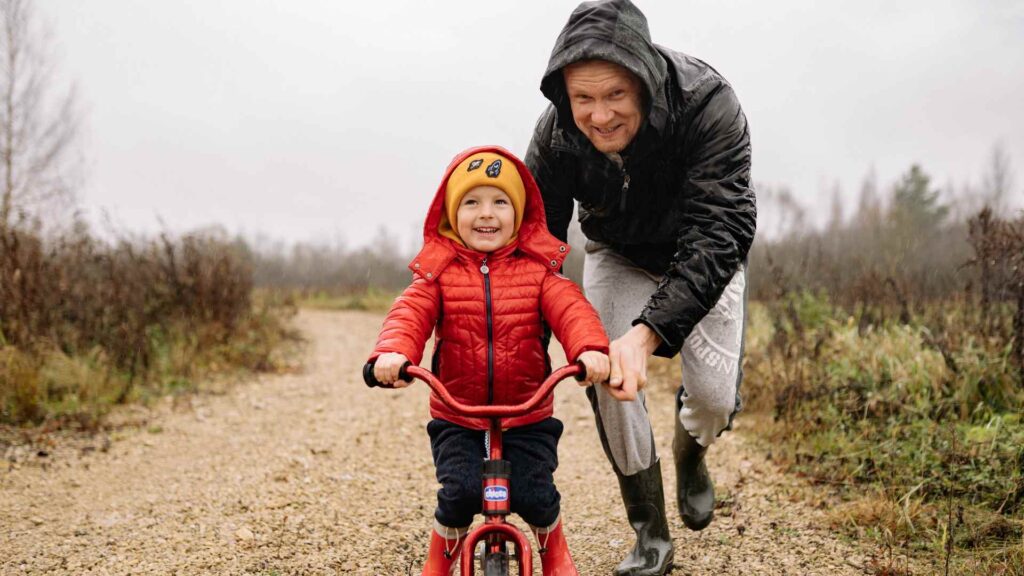
Choose the Right Learning Environment
- Quiet Areas: Select a traffic-free zone or empty parking lot to practice. This removes potential hazards and distractions so your child can focus on pedaling and balancing.
- Smooth Surfaces: Avoid gravel or uneven terrain during the early stages. A flat, paved surface helps build confidence and reduces the risk of falls.
- Familiar Spaces: Practicing in a local park or your driveway can make your child feel more at ease, as they’re in a comfortable setting.
Set Realistic Expectations
- Short Sessions: Keep initial lessons brief—15 to 20 minutes of practice is enough for younger kids. This prevents them from getting overwhelmed or fatigued.
- Positive Reinforcement: Praise your child for small victories. Whether it’s successfully balancing for a few seconds or learning how to brake gently, a few kind words can go a long way.
- Model Enthusiasm: Show excitement when it’s time to practice. Let them see you smiling and offering enthusiastic support. This sends the message that biking is a joyful activity.
Encourage Exploration
- Hands-On Introduction: Let your child explore their bike—touching the tires, testing the brakes, spinning the pedals. This hands-on experience piques their interest.
- Storytime: Read books or watch short videos about biking adventures. This can inspire their imagination and give them something to aspire to.
- Peer Influence: If possible, have your child observe or talk to friends or siblings who already bike. A bit of peer encouragement often boosts confidence.
By laying a solid foundation and positive mindset, you’ll ensure your child associates biking with fun, personal growth, and family adventure.
This sets the stage for a smooth journey ahead, where every pedal stroke becomes a step toward increased independence and excitement.
Choosing the Right Gear: Bikes, Helmets, and Accessories
Selecting proper biking gear is crucial for comfort, safety, and long-term enthusiasm.
Kids who have a well-fitting bike, sturdy helmet, and fun accessories are more likely to enjoy the learning process.
The right equipment also helps them develop good habits—like wearing a helmet without question.
Bikes Suited to Their Size
- Measure Inseam: Focus on your child’s inseam rather than age to determine the appropriate bike size. A child should be able to rest their feet flat on the ground when seated.
- Adjustable Seat Height: Opt for a bike with a seat that can easily be raised or lowered. This allows for flexibility as your child grows or gains confidence.
- Lightweight Frames: A lighter bike is easier to control, especially for beginners. Avoid overly heavy frames that can discourage new riders or strain their muscles.
- Check Braking Systems: Some children do better with coaster (back-pedal) brakes before moving on to hand brakes. Others find hand brakes intuitive from the start.
Helmet Safety and Fit
- Proper Sizing: Helmets come in various sizes. Measure your child’s head circumference and choose accordingly. A well-fitting helmet shouldn’t rock back and forth.
- Helmet Position: The helmet’s brim should be about two finger-widths above the eyebrows. Straps should form a “V” around the ears, meeting just below the ear lobe.
- Chin Strap Test: Fasten the chin strap snugly, allowing one finger to fit between the strap and the chin. If the helmet tilts or moves, readjust until it’s stable.
- Regular Inspections: Check for cracks, dents, or worn-out straps. Replace helmets after any significant impact—even if there’s no visible damage.
Essential Accessories
- Knee and Elbow Pads: While not mandatory, these can boost your child’s confidence, especially if they’re worried about falling.
- Reflectors or Lights: For children biking in low-light conditions, add reflectors or LED lights to increase visibility.
- Bell or Horn: Kids love using a bell or horn, and it also teaches them to signal their presence to others.
- Dress for Success: Closed-toe shoes with good traction are essential for pedaling. Encourage clothing that’s comfortable and won’t get caught in chains or wheels.
Fostering Good Habits Early
- Routine Checks: Before each ride, do a quick inspection. Check tire pressure, brake response, and handlebar alignment. This teaches children to respect and maintain their equipment.
- Clean and Store Properly: Show your child how to wipe down and store their bike in a safe, dry place. This keeps gear in good shape while instilling a sense of responsibility.
Choosing the right gear sets the tone for safe, enjoyable biking adventures. With a bike that fits properly, a helmet secured just right, and helpful accessories, your child will be ready to tackle the next step with greater confidence.
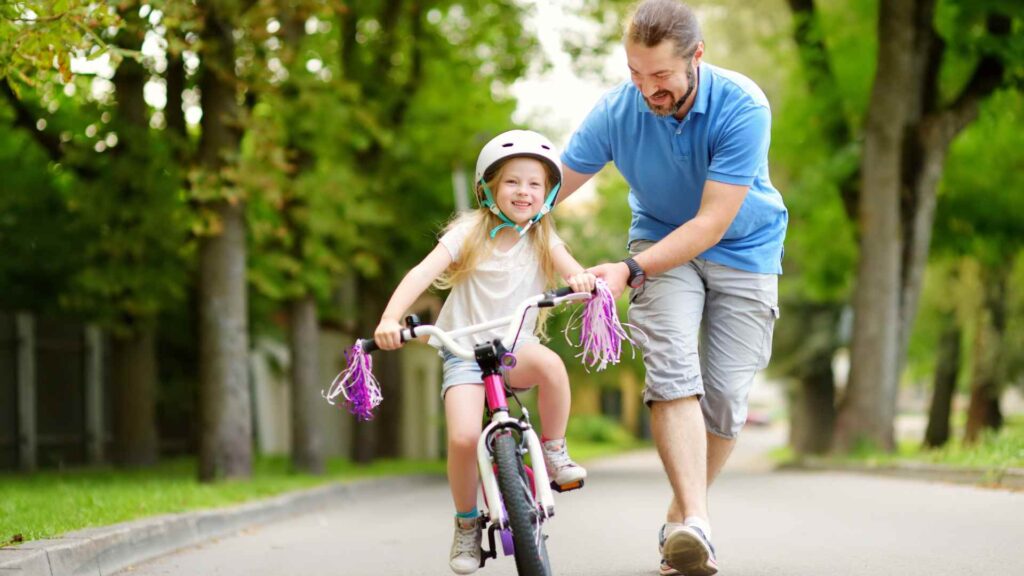
Balancing Act: Training Wheels vs. Balance Bikes
For many parents, deciding between traditional training wheels and balance bikes can be daunting.
Both approaches teach skills in slightly different ways, but each can effectively prepare your child for independent pedaling.
The key is understanding your child’s learning style and comfort level before deciding which route to take.
Balance Bikes
- Focus on Balance: Balance bikes eliminate the need for pedals, letting children concentrate entirely on stabilizing themselves. By scooting along, they naturally develop balance at their own pace.
- Smooth Transition to Pedals: Once kids master gliding confidently, switching to a regular bike often involves just adding pedals. They already know how to maintain balance.
- Lightweight and Maneuverable: Balance bikes are usually lightweight, making them easier for smaller children to handle.
- Confidence Builder: Eliminating the fear of wobbling can boost a child’s self-esteem. Once they can “stride” confidently, their excitement to move onto pedaling grows rapidly.
Training Wheels
- Gradual Learning Curve: Training wheels allow kids to learn pedaling, braking, and steering without worrying about tipping over. This can be ideal for children who need extra time adjusting to multiple skills.
- Adjustable Support: Parents can raise the training wheels progressively as their child gains confidence, encouraging the child to balance more on their own.
- Familiar Option: Many parents learned with training wheels and feel comfortable introducing them to their children, making it a traditional choice.
- Potential Dependence: Children may become reliant on training wheels, delaying true balance development. Consistent monitoring and gradual adjustments help mitigate this risk.
Key Considerations
- Age and Maturity: Younger children might benefit more from balance bikes, while older kids might prefer training wheels to get used to pedaling right away.
- Personality: Some kids are bold and eager to test their limits, while others prefer a more secure approach. Gauge their temperament to choose the best method.
- Opportunity for Practice: If you have safe, open areas to practice gliding, a balance bike might work well. If riding space is limited, training wheels might feel more secure.
- Transition Plan: If you start with training wheels, have a clear plan for gradually lifting or removing them. If you start with a balance bike, ensure you know when to introduce pedals.
Making the Decision
- Test Runs: If possible, let your child try both at a local bike shop or with a friend’s bike. Observing their reaction and ease can guide you toward the best option.
- Remain Flexible: Keep an open mind. It’s okay to switch strategies if your child isn’t thriving with the initial choice.
- Focus on Fun: Whichever method you choose, prioritize enjoyment. Children learn best when they’re having a good time and feeling supported.
In the debate between training wheels and balance bikes, there’s no one-size-fits-all answer. By evaluating your child’s readiness and personal preferences, you can pick the perfect method to help them cruise into a world of biking fun.
Riding Basics: Building Essential Skills and Confidence
Once the gear is chosen and the bike style decided, it’s time to hit the pavement—literally. Teaching the basics of riding requires patience, creativity, and a step-by-step approach. The primary goals at this stage are to develop balance, steering, pedaling, and braking skills without overwhelming your child.
Starting Off Right
- Mounting the Bike: Show your child how to properly get on the bike by straddling it and keeping at least one foot on the ground. This stabilizes them before they attempt to pedal.
- Hand Position: Encourage a relaxed grip on the handlebars. Too tight, and it might make steering jerky. Too loose, and they may struggle to maintain control.
- Body Posture: A slight bend in the elbows and a tall spine helps maintain balance. Encourage them to look ahead rather than down at the front tire.
Mastering Pedals and Balance
- One Foot Down Method: With training wheels or not, have them start by placing one foot on the pedal in the “ready” position (about the 2 o’clock position on the pedal’s rotation). This gives momentum when they push off.
- Push-Off Drill: Let them practice small push-offs repeatedly until they can maintain balance for a few seconds.
- Glide Practice: If using a balance bike or if training wheels are slightly raised, practice gliding down gentle slopes to develop steady equilibrium.
Steering and Turning
- Look Where You’re Going: Children often steer where they look, so encourage them to focus on a clear target straight ahead or the exit of a turn.
- Gentle Turns: Start with wide, shallow turns. Guide them to gently lean their bike in the direction they want to go without oversteering.
- Practice Drills: Set up a simple obstacle course with cones or chalked lines on the pavement. Navigating mild curves is an excellent way to develop steering skills.
Braking Basics
- Coaster vs. Hand Brakes: Demonstrate how to engage coaster brakes by pedaling backward or how to gradually squeeze hand brakes without slamming them.
- Slow Speed Drills: Practice braking at walking speed. Ask your child to stop at a specific marker or line. Gradually increase the speed as they get comfortable.
- Gentle Pressure: Emphasize controlled, gentle braking—especially if they’re using front hand brakes. Harsh squeezing can cause abrupt stops or tipping.
Pacing the Lessons
- Celebrate Progress: Even if it’s just 20 seconds of balanced riding or a smoother turn than before, celebrate small improvements.
- Short, Frequent Sessions: Consistency is key. Frequent 15–20 minute sessions help reinforce muscle memory without causing burnout.
- Mix in Play: Encourage kids to race you in slow-motion or try riding in silly patterns. Integrating play keeps morale high and teaches skills organically.
By patiently guiding them through these foundational skills, you’ll watch your child’s confidence soar. It’s in these moments—finding balance for the first time, successfully braking at a stop sign—that they discover the joy and freedom biking provides.
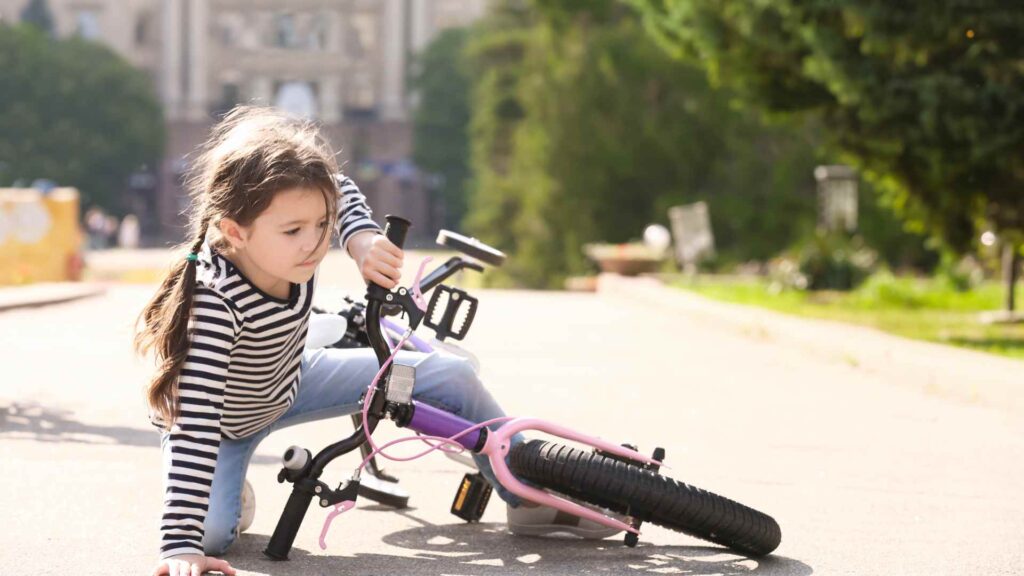
Safety First: Helmets, Pads, and Road Awareness
No guide to introducing biking would be complete without a significant focus on safety.
Ensuring that your child rides responsibly goes far beyond wearing a helmet—though that’s an excellent start.
From understanding traffic rules to anticipating common hazards, proper safety training nurtures a responsible and confident rider.
Essential Protective Gear
- Helmet Habits: We’ve discussed the importance of a well-fitted helmet, but also stress consistency. Make helmet-wearing a non-negotiable rule.
- Pads and Gloves: If your child is new or prone to falls, knee and elbow pads offer peace of mind. Fingerless cycling gloves also protect against scrapes while improving grip.
- Shoes and Clothing: Closed-toe shoes, preferably with rubber soles, keep feet secure on the pedals. Avoid loose clothing that might get caught in the chain.
Road Awareness for Kids
- Learning Road Signals: Teach basic hand signals for turning left, turning right, and stopping. Practice them in a safe space until they become second nature.
- Looking Both Ways: A fundamental rule. Before crossing a street or intersection, look left, look right, and look left again. Emphasize the importance of constant alertness.
- Mind the Corners: Remind your child that cars and other cyclists might not see them right away when they come around a corner. Slowing down and being ready to brake is crucial.
Neighborhood and Park Etiquette
- Share the Path: If biking on sidewalks or shared trails, teach your child to be mindful of pedestrians, joggers, and other cyclists. A quick “On your left!” warning can help avoid collisions.
- Stop Signs and Lights: Even if they’re on a sidewalk, it’s vital to respect traffic signals. Practicing real-world riding scenarios with you by their side instills good habits.
- Yielding to Larger Traffic: Stress the importance of letting cars pass and waiting for the road to clear, even if they technically have the right of way.
Supervised vs. Independent Riding
- Age and Maturity: Determine when they can ride unsupervised by evaluating their ability to follow rules, check for hazards, and remain aware of their surroundings.
- Practice Rides: Start with short, supervised neighborhood rides to help them gain real-world road experience under your watchful eye.
- Emergency Preparedness: Talk about what to do if they encounter a dog, a stranger, or an unforeseen obstacle. Having a plan fosters confidence and quick thinking.
Ongoing Reinforcement
- Positive Role Modeling: Practice what you preach. Wear a helmet, follow traffic rules, and maintain caution. Children learn by example.
- Reward Safe Behavior: Compliment and reward your child when they follow safety protocols without reminders. This recognition reinforces responsible biking habits.
- Refreshers: Regularly review safety rules, even if they seem repetitive. Consistent reinforcement ensures these rules become second nature.
By combining protective gear, road awareness training, and parental guidance, you set your child on a path toward a lifetime of safe, responsible cycling. When safety becomes second nature, biking transforms into an empowering and rewarding activity for kids of all ages.
Motivation and Encouragement: Keeping the Fun Alive
Learning to ride a bike shouldn’t feel like a chore. If your child associates biking with joy, camaraderie, and celebration, they’ll be more likely to stick with it long after the training wheels or balance bike days. Here’s how to keep the spark alive and foster a genuine love for riding.
Celebrate Milestones
- First Pedal Stroke: Throw a mini “pedal party” when your child first masters riding more than a few feet without assistance.
- Progress Photos: Document each new achievement—balancing without wobbling, making a smooth turn, or riding a certain distance. This visual record fuels pride and motivation.
- Family Applause: Gather siblings or extended family to cheer them on during practice. A little fanfare can go a long way in boosting confidence.
Gamify the Experience
- Obstacle Courses: Chalk out a fun course on the driveway. Include gentle curves, mini-stop signs, and “parking spots” to teach control and safety while having fun.
- Treasure Hunts: Hide small tokens or treats along a short bike route. Encourage your child to find them as they ride, turning practice into an adventure.
- Friendly Races: Challenge your child to slow or moderate-speed races. Let them win sometimes to keep motivation high, while still teaching the value of friendly competition.
Variety in Practice
- Different Locations: Explore new parks, bike trails, or even short camping trips with bike-friendly paths. Changing scenery keeps boredom at bay.
- Group Rides: Organize a weekend ride with other families. Children enjoy socializing, and seeing peers master biking can be inspiring.
- Themed Rides: Turn a bike ride into an imaginary safari or a quest for hidden treasure. Using their imagination makes each ride exciting.
Encouraging Independence
- Allow Choice: Let your child pick the route or decide the time of day to practice. Giving them a say fosters ownership and enthusiasm.
- Incremental Freedoms: Gradually increase their independence, like letting them bike to a neighbor’s house under your supervision. As they prove responsible, loosen the reigns slightly.
- Lead by Example: Your involvement—riding alongside or showing genuine enthusiasm—teaches them that biking is a lifelong activity, not just a childhood phase.
Supporting Emotional Ups and Downs
- Be Patient: Frustration is normal. If your child is struggling or has a fall, calmly help them up, reassure them, and gently encourage another try later.
- Focus on Effort: Praising perseverance rather than just results teaches kids resilience. Emphasize the thrill of trying their best, regardless of immediate success.
- Open Dialog: Encourage your child to share their feelings about biking. If they’re scared, acknowledge it and work on small steps to overcome those fears.
Keeping the fun factor front and center ensures biking remains an activity they look forward to. Over time, this enthusiasm transforms them from wobbly beginners into confident riders who look at a bike not as a challenge but as a gateway to adventure.
Overcoming Challenges: Common Obstacles and How to Solve Them
Even the most enthusiastic child can encounter stumbling blocks—physical, emotional, or practical—on their biking journey. Identifying and addressing these challenges quickly can help them stay engaged and keep progressing. Here are some frequent hurdles and strategies to navigate them.
Fear of Falling
- Gradual Progression: Start with activities that bolster balance in a low-risk setting. Practice on soft grass, for instance, or hold onto the seat lightly for stability.
- Talk it Through: Acknowledge their fear. Reassure them that minor tumbles are part of learning. Share your own stories of falls and how you got back up.
- Protective Gear: Wearing pads and gloves can psychologically ease fears, making it less intimidating to try new skills.
Difficulty Balancing
- Adjust the Bike: Ensure the seat is at the correct height. If it’s too high or low, balancing becomes more difficult.
- Short Sessions: Frequent, shorter sessions improve balance over time. Consistency is more effective than one long session that ends in frustration.
- Core Strength Games: Off the bike, engage in activities like playing catch while standing on one leg or hopping. Improved core strength translates to better balance on the bike.
Lack of Motivation
- Frequent Breaks: If your child is losing interest, switch gears. Offer a quick snack or play another game. Return to biking once they’ve recharged.
- Positive Reinforcement: Encourage them by highlighting how much they’ve improved since they started. Sometimes kids need a gentle reminder of their progress.
- Shared Goals: Propose a small “destination ride,” such as biking to the ice cream shop or the local playground. A tangible, fun goal can reignite motivation.
Struggling with Pedaling Technique
- Pedal Position Drills: Practice the “ready” position repeatedly. Focus on smooth rotations.
- Coaster vs. Hand Brakes: Sometimes confusion about brakes can disrupt pedaling. Demonstrate how to pedal forward fully and brake only when needed.
- Music and Rhythm: Some children respond well to cycling to a song or beat, maintaining a steady pace that matches the music.
Managing Hills
- Start on Gentle Slopes: Before tackling steeper hills, let them practice climbing and descending mild inclines.
- Teach Gearing (for Older Kids): If the bike has gears, show them how to shift to an easier gear when climbing.
- Descending Safely: Coach them to apply gentle braking in intervals rather than one long brake. Encouraging them to look ahead helps maintain control.
Parental Frustration
- Reset and Re-evaluate: If both you and your child are frustrated, step away from biking for a day or two. Sometimes a mental break is needed.
- Adjust Expectations: Every child learns at their own pace. Don’t compare them to siblings or friends. Focus on their individual progress.
- Ask for Help: If you’re stuck, consider getting advice from other parents, joining a local kids’ biking group, or even hiring a short lesson from a professional instructor.
By proactively addressing these common barriers, you ensure that small setbacks don’t turn into long-term deterrents. Overcoming challenges builds resilience—an essential skill both on and off the bike—and helps your child discover that persistence is the key to mastery.
Beyond the Basics: Exploring New Terrains and Adventures
Once your child is comfortable pedaling around the neighborhood, it’s time to broaden their biking horizons. Introducing new environments and challenges keeps them engaged and enriches their riding experience. From scenic trails to mountain biking paths suited for beginners, there’s a whole world to explore.
Local Bike Trails and Parks
- Safety First: Research trails designated for family or novice cyclists. These are typically well-maintained paths with minimal traffic.
- Nature Exploration: Point out local flora and fauna along the route. Encourage your child to spot birds, squirrels, or interesting plants, transforming a bike ride into an educational outing.
- Pack the Essentials: Bring water, snacks, and a small first-aid kit. Longer rides require regular hydration breaks and energy boosts.
Gradual Terrain Progression
- Slight Inclines: Start with mild slopes to build leg strength and confidence. Gradually move to more challenging terrain as they improve.
- Off-Road Adventures: If your child shows an interest in dirt trails or light gravel paths, make sure their bike tires and skills are up to the task.
- Introduce Gears: For older kids using multi-speed bikes, teach them how to shift gears when climbing hills or riding at different speeds.
Organized Rides and Events
- Family Bike Rallies: Many communities host family-friendly biking events. Participating can give your child a sense of accomplishment and belonging.
- Kids’ Bike Camps: Short summer bike camps or clinics often cater to various skill levels. They introduce new skills like maneuvering around obstacles and basic bike maintenance.
- Local Biking Groups: Joining a local cycling group can motivate your child by letting them ride alongside peers, discover new trails, and pick up new techniques.
Staying Adventurous Safely
- Detailed Planning: Before venturing into unknown territory, check maps and read online trail reviews to anticipate difficulty levels and prepare accordingly.
- Buddy System: Avoid letting your child ride completely alone in new areas. Pair them with friends or family, and maintain communication (consider walkie-talkies or a simple phone if appropriate).
- Reflective Gear: If there’s a chance you’ll be out near dusk, bring reflective vests or bright clothing to increase visibility.
Expanding Skills
- Learning Minor Maintenance: Teach your child how to fix a flat tire or adjust their seat. This can turn a mechanical hiccup into a learning opportunity.
- Track Progress: Keep a bike journal noting distances covered, new trails discovered, and personal improvements. Your child can look back and see how far they’ve come.
- Set Challenges: Encourage them to set simple goals: biking a certain distance without stopping, trying a light off-road trail, or mastering a gear shift on a hill.
By exploring beyond your usual routes, biking remains an ever-evolving adventure rather than a routine chore. The more varied the experiences, the more your child’s confidence will grow—helping them appreciate that their two-wheeled friend can carry them on all sorts of journeys.
Building Family Bonds: Incorporating Biking into Your Lifestyle
Biking can be more than just a childhood milestone; it can become a cherished family activity that fosters connections, creates memories, and sets the tone for a health-conscious lifestyle. When the entire family embraces biking, children see it as a shared passion rather than a task.
Family Rides and Outings
- Weekend Traditions: Designate a Saturday or Sunday morning for a family bike ride. This weekly ritual can become something everyone looks forward to.
- Picnic Biking: Choose a scenic route that ends in a picnic spot. Pack sandwiches and healthy snacks, transforming the ride into a mini-adventure.
- Holiday Biking: Incorporate biking into holiday traditions, like a short Thanksgiving Day ride before dinner or a Christmas Day spin around the neighborhood.
Fitness and Health
- Active Lifestyle: Regular bike rides can help maintain a healthy weight and develop cardio fitness for both kids and adults.
- Habit Formation: When children see biking as a regular part of life, they’re more likely to stay active as they grow older, reducing screen time in favor of outdoor play.
- Stress Relief: Family rides offer a chance to unwind and connect. Pedaling through nature can be a soothing activity that reduces stress for everyone involved.
Shared Experiences and Communication
- Bike Talk: Riding together provides uninterrupted family time. Use these moments to chat about school, friendships, or future plans without the usual digital distractions.
- Problem-Solving Together: Encountering a flat tire or a tricky hill? Work as a team to address these issues. Shared challenges create memories and build stronger relationships.
- Healthy Competition: Friendly bike races or timed challenges can spark fun competitiveness. Everyone in the family can celebrate each other’s victories and improvements.
Community Connection
- Charity Rides: Participate in charitable bikeathons. Teaching children the value of giving back while enjoying their favorite activity fosters empathy and community spirit.
- Local Events: Neighborhood parades or community bike festivals let kids show off their skills and connect with peers.
- Lead by Example: If parents bike to work or for errands occasionally, children learn that bikes aren’t just for recreation but also a practical, eco-friendly transport option.
Long-Term Family Traditions
- Annual Goals: Set a collective family goal—like covering a certain number of miles or visiting a specific scenic trail. Celebrating this goal strengthens family unity.
- Vacation Biking: Add a biking element to family vacations. Explore new cities or national parks on two wheels for an immersive experience.
- Scrapbook Memories: Document rides with family photos and souvenirs. Over time, this scrapbook becomes a testament to your family’s growth and shared adventures.
By integrating biking into family routines, you transform it from a solo achievement into a collective lifestyle choice. The bonding experiences, health benefits, and shared accomplishments will remain with your child long after they outgrow their first set of wheels.
